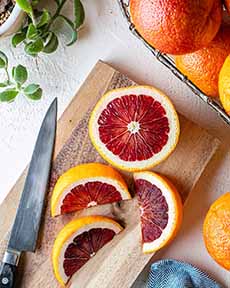Blood Orange Sangria Recipe & Types Of Blood Oranges
|
|
Blood oranges lovers: It’s high season for the luscious, rosy orbs. Blood oranges are available between October and May, with their prime season right now: February and early March. Select those that are firm to the touch. They’ll keep in the fridge for two weeks. The red color comes from the presence of the antioxidant anthocyanin, which creates a red, blue, or purple color, depending on a variety of factors from climate to soil. The darker the color, the more anthocyanin in the fruit or vegetable. These are the compounds that are thought to help prevent cancer and heart disease. (Here’s more about antioxidants.) Blood orangeslook exactly like regular oranges on the outside, but their inside flesh is a deep rosy red color, and the flavor is a cross between orange and raspberry—some people call them “raspberry oranges.” There are three main varieties: This recipe is from Chef Aida Mollencamp. Prep time is just 5 minutes, plus at least 4 hours to chill. You can squeeze blood oranges, and many markets also sell ready-to-drink blood orange juice. Preparation 1. PREPARE the fruit, washing and slicing as indicated. 2. STIR together in a large pitcher or bowl the wine, blood orange juice, ginger liqueur, orange liqueur, a pint of raspberries, and a pint of strawberries. Cover and refrigerate for at least 4 and up to 24 hours. 3. TO SERVE: Strain the sangria into a pitcher and discard the soaked berries. Add a few fresh raspberries, strawberries, and all the sliced kumquats and blood oranges. Serve sangria poured over ice with a few slices of orange in each glass. > THE HISTORY OF ORANGES |
|






